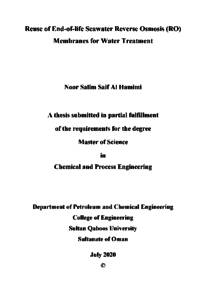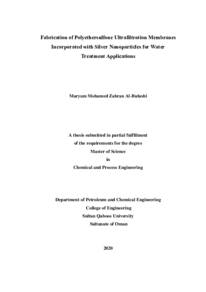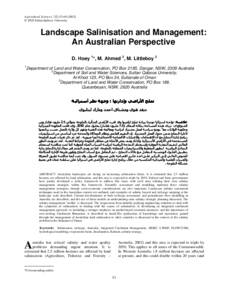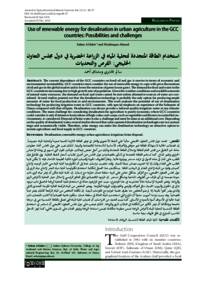وثيقة
Reuse of end-of-life seawater reverse osmosis (RO) membranes for water treatment.
الناشر
Sultan Qaboos University.
ميلادي
2020
اللغة
الأنجليزية
الملخص الإنجليزي
Reverse osmosis (RO) membrane technique is considered as the most widely used
desalination technology around the world. Based on the continuing growth in RO
desalination plants, and the finite lifespan of the RO membranes (due to many factors
including irreversible fouling and physical and chemical damage), large stocks of the endof-life (EoL) RO membranes that are no longer suitable to be used in seawater desalination
have been accumulated over the years. It is estimated that more than 840,000 modules of
the EoL SWRO membranes are discharged annually worldwide, mostly in landfills, which
is becoming a critical challenge in RO desalination industry. The overall objective of this
work is to validate the possibility of direct reuse of the end-of-life seawater reverse
osmosis membranes for brackish water treatment in order to limit the environmental
impacts of their direct disposal, as well as reducing costs of purchasing new filtration
membranes. In this study, membrane performance and surface characterization (including;
TGA, FTIR, SEM/EDS and WCA analyses) were assessed using four end-of-life seawater
reverse osmosis (EoL SWRO) modules. These end-of-life modules are classified as
follows; EoL-M1, EoL-M2, EoL-M3 and EoL-M4, and were cleaned prior to be analyzed
using a combined acid-base cleaning (6% w/v sodium hydroxide and 6% w/v citric acid).
The hydraulic performance of old membranes was assessed using 2 feeds; deionized water
and 5,000 mg/L synthetic NaCl solution, and was compared to the performance of 2
commercial membranes (BW30 and NF90) aiming their reuse in different lower-grade
applications. Removal of common salts represent in natural water sources (Na2SO4,
Mg2SO4 and MgCl2) and humic substances was also investigated using EoL membranes.
As a third part of the experimental work, the direct reuse of end-of-life RO membranes
was evaluated using natural brackish water (5,000 mg/L) in order to validate the direct
reuse of end-of-life SWRO membranes for brackish water filtration with little or no
treatment. Cross flow RO system with an active membrane area of 55.4 cm2 was used to
conduct all tests at around 10 bars. It was shown that 84.1-92.0% NaCl rejection was
achieved by direct reuse of end-of-life seawater RO membranes, which was higher than
the rejection characteristics obtained using commercial BW30 membrane. Additionally,
it has been shown that rejection of Na2SO4, MgSO4 and MgCl2 salt solutions was in the
range of (50.0-85.8%) with a highest rejection value was obtained for Na2SO4 and the
lowest rejection was observed for MgCl2 solution, while a complete rejection was
achieved for humic acid. These results showed a great promise of the direct reuse of the
EoL SWRO membranes within lower throughput systems (i.e. seawater pretreatment and
brackish water treatment). The direct reuse of the EoL SWRO membranes for brackish
water filtration showed that salt rejection performance of the EoL-M1, EoL-M3 and EoLM4 membranes presented NF-like properties. While salt rejection observed using EoLM2 was intermediate between the commercial NF and BW30 membranes. Overall, all
iv
reused membranes showed lower permeate flux and higher salt rejection values than the
aforementioned commercial membranes. Additionally, the permeate water quality
observed by using seawater EoL reverse osmosis membranes for brackish water filtration
showed TDS values in the range of 800-1300 mg/L, which was within the permissible
limit of irrigation water. Therefore, this product water could be used to cover some of the
agricultural water demands. However, in some cases, this water is required to be
remineralized by blending with raw water to adopt the chemical characteristics as a
function of crops requirements
المجموعة
URL المصدر
الملخص العربي
تعتبر تقنية التناضح العكسي من أكثر التقنيات المستخدمة لتحلية المياه في العالم. وقد أدى تزايد استخدام أغشية التناضح العكسي في محطات معالجة المياه وتأثرها بالعديد من الترسبات والأضرار الفيزيائية والكيميائية الناتجة عن عمليات معالجة المياه والتي تؤدي إلى تلفها مع مرور الزمن إلى تراكم أعداد كبيرة من الأغشية غير الصالح ة لالستخدام في تحلية مياه البحر مرة أخرى. تشير الأحصائيات إلى أن محطات تحلية المياه بتقنية التناضح غشاء تناضح عكسي في مدافن النفايات سنوياً العكسي تتخلص مما يقارب 000,840 ، وهو ما يشكل تحديًا كبي ًرا في هذا المجال. من هذا المنطلق يهدف هذا المشروع إلى البحث عن إمكانية إعادة استخدام أغشية التناضح العكسي )RO )التالفة والتي تم استخدامها لتحلية مياه البحر سابقا لمعالجة مياه أخرى أقل ملوحة وذلك للحد من الأثار البيئية للتخلص المباشر منها، وكذلك لتقليل تكاليف شراء أغشية ترشيح جديدة الستبدال الأغشية التالفة. في هذه الدراسة؛ تم استخدام أربع وحدات تناضح عكسي قديمة لتقييم أداء أغشية التناضح العكسي وتوصيف السطح )بما في ذلك، تحليالت (FTIR،EDS/ SEM، WCA وTGA .)وتم تصنيف الأغشية المستخدمة في هذا البحث كالتالي: M-1EoL،M-2EoL،M-3EoL و M-4EoL .كما تم تنظيفها قبل الأستخدام باستخدام 6 %من محلول هيدروكسيد الصوديوم و6 %من محلول حمض الستريك. وتم تقييم أداء الأغشية في المرحلة الأولى باستخدام الماء النقي، ثم باستخدام المحلول الملحي )NaCl )بتركيز 5000 ملجرام/ لتر. كما تم مقارنة أداء الأغشية القديمة بأغشية تناضح عكسي جديدة وهي: BW30 و(Nanofiltration (NF90 بهدف إعادة استخدامها لمعالجة مياه أقل ملوحة. وبالأضافة إلى ذلك، تم اختبار فاعلية أحد الأغشية القديمة )M-4EoL )في إزالة بعض الأملاح الشائع وجودها في مصادر المياه الطبيعية (MgCl2 and MgSO4, Na2SO4 (كما تم اختبار إزالة المواد الدبالية ) Humic substances )باستخدام جميع الأغشية القديمة. وكجزء ثالث من العمل التجريبي تم إثبات فعالية إعادة استخدام أغشية التناضح العكسي المباشر لمعالجة المياه الجوفية المالحة )5000 ملجرام/ لتر(. وبعد أن تم تقييم أداء الأغشية القديمة باستخدام 5000 ملجرام / لتر من محلول كلوريد الصوديوم )NaCl ،)تبين أن كفاءة هذه الأغشية لفصل الأملاح تصل إلى 1,84-0,92 ،%وهي أعلى من كفاءة الفصل ألغشية التناضح العكسي الجديدة )BW30 وNF90 .)كما نجحت إعادة استخدام غشاء التناضح العكسي القديم M-4EoL في فصل المحاليل الملحية المختلفة (MgCl2 and MgSO4, Na2SO4 (بكفاءة تصل إلى 0,50 -8,85 ،%وفصل المحلول الدبالي بنسبة تصل إلى 100 .%كما أظهرت نتائج البحث إمكانية استخدام الأغشية النفاذية القديمة (reverse seawater life-of-End membranes osmosis )لمعالجة المياه متوسطة وقليلة الملوحة كمعالجة المياه الجوفية أو المعالجة الأولية لمياه البحر. وأظهرت نتائج البحث أن كفاءة الأغشية القديمة لفصل الأملاح )M-1EoL ،M-3EoLو M-4EoL )من المياه المالحة )water Brackish )تشبه خصائص غشاء الNF90 .بينما أعطى غشاء M-2EoL كفاءة أعلى . وبشكل عام أظهرت جميع الأغشية المعاد استخدامها تدفقاً لفصل الأملاح بين خصائص غشاء NF90 وBW30 لل منخفضا ماء المعالج وكفاءة أعلى لفصل الأملاح مقارنة بالأغشية التجارية المستخدمة للمقارنة. بالأضافة إلى ً ذلك، بلغ تركيز المياه المعالجة باستخدام الأغشية القديمة 800 -1300 ملجرام/لتر وهي ضمن الحد المسموح به لتركيز الأملاح في مياه الري )500-2000 ملجرام/لتر(. ولذلك أثبت هذا البحث إمكانية استخدام أغشية التناضح العكسي التالفة المستخدمة سابقا في تحلية مياه البحر لمعالجة المياه الجوفية وإنتاج مياه صالحة للزراعة بعد أن تتم معادلتها بالماء الخام لتعديل الخصائص الكيميائية بما يتوافق مع حاجة المحاصيل الزراعية.
قالب العنصر
الرسائل والأطروحات الجامعية




